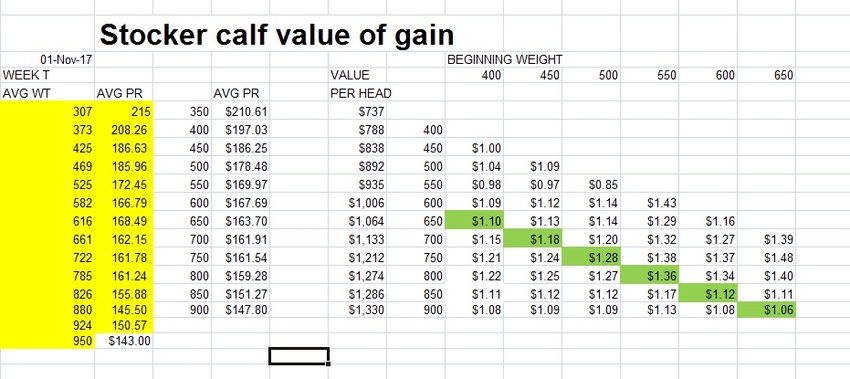
Stocker prices have risen overall this fall, but opportunities for profit between weight classes have actually narrowed a bit in the past couple weeks.
When Beef Producer analyzed price slides (roll-back) two weeks ago, values of gain reached as high as $1.75 per pound when starting cattle at weights around 550 pounds and moving up to 600 or 650 pounds. Several categories in that area offered potential values of gain in the $1.60 per pound range.
This week, again using the Oklahoma City pricing for large-framed, No. 1 steers, the highest values of gain ranged from $1.30 to $1.48 per pound.
The highest value between weight classes still exists from about 550 pounds to 750 pounds, but only by a few dollars.
However, depending on what it really costs you to put weight on cattle, you may have profit opportunities across several of these weight classes, with value of gain from $1 to $1.48 per pound. Of course, this is based on predicting prices and price spreads will remain roughly in the range where they currently are.
Sell-buy opportunities look reasonable, as well, with overall value for calves of 750-800 pounds fetching $1,212 to $1,274 compared with 450-500-pound calves, for example, costing $838-892. That sort of sell-and-buy transaction would turn a profit in the neighborhood of $380 per animal. Depending on your cost to keep those animals and your rate of gain, that could be a reasonable return.
The Chicago Mercantile Exchange's daily livestock report noted through September and October that yearling feeder cattle prices staged an impressive rally of more than $10 per hundredweight at a time of year when prices usually trend sideways or lower.
However, the Merc's commentators wrote that the difference between steers weighing 500-550 and 750-800 pounds was only $9 per hundredweight, and the smallest since 2010 and 2011. For comparison, they noted the price spread in October 2014 was $46 per hundredweight. They added the difference may be attributable to a slower herd-building pace, together with wholesale beef prices 10% lower and slaughter-cattle prices 20% lower than they were in 2014. In addition, there now exist much larger supplies of competing pork and poultry.
To learn more about sell-buy marketing, consider Wally Olson's marketing school upcoming in Claremore, OK, Nov. 14-17. His website is http://olsonranchllc.com/
About the Author(s)
You May Also Like




